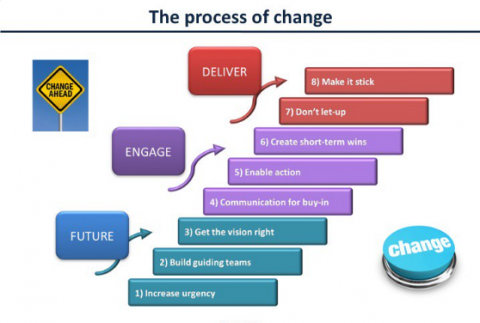Can school leaders rely on Kotter's change management model?
A few weeks ago I wrote about the need for school leaders to be appropriately critical of educational and management gurus.
One such guru is John Kotter, whose name is often found on lists of the world's leading management thinkers. But Kotter's influence is not just limited to business – last month, leading educationalist Andy Buck, author of the popular book Leadership Matters tweeted: "When it comes to change, you can't beat Kotter".
With that in mind, I thought it might be useful to see if there's any empirical evidence to support Kotter's most well-known model, the eight-step process for leading change.
Back in 2012, Steven Appelbaum, Sally Habashy, Jean-Luc Malo and Hisham Shafiq looked at 15 years of change management literature to see whether there is evidence to support Kotter's claims. Their paper, Back to the future: revisiting Kotter's 1996 change model, will be the primary source of evidence as we look at the evidence behind Kotter's work.
The model was first published in 1995 in the Harvard Business Review, then as a book Leading Change in 1996. Kotter has since revisited the model in his 2014 book, Accelerate, but this was how it stood in 1996:
- Establish a sense of urgency about the need to achieve change
- Create a guiding coalition
- Develop a vision and plan
- Communicate the change vision
- Empower broad-based actions
- Generate short-term wins
- Consolidate gains and produce more change
- Anchor new approaches in the corporate culture.
As Applebaum et al note, Leading Change is based on Kotter's own personal research and business experience – there are no supporting footnotes, references or bibliography. A wider review of change management literature found support for most of the steps, although no research studies were found covering all eight steps in one model. As such Applebaum et al note that Kotter's change management model gains its popularity from its practicality, rather than a robust evidence base proving its success.
Applebaum et al then argue that Kotter's model might not be appropriate for all types of change. They identify a number of situations where the model might not be applicable without modifications. For example:
- It is a rigid approach. Kotter argues that the eight steps should be followed in sequence. Such a prescriptive approach might not be consistent with an organisation's culture, however, which could undermine change efforts.
- Some steps are not relevant in some contexts. For example, some changes may be irreversible so you would not need to consolidate change or anchor it in the organisation's culture as seen in steps seven and eight.
- The model does not provide enough actionable detail to deal with all the difficult situations you encounter during change management. If there are high levels of resistance to change or the change does not generate initial short-term wins, for instance, you may need to take extra actions to overcome such difficulties.
- There is a lack of the research around the model in practice. Very few, if any studies, particularly in schools, have formally tried to capture how the full eight-stage process has been implemented.
The implications for school leaders
Applebaum et al argue that Kotter's eight steps provide a useful checklist for leaders and managers who wish to bring about change. Any school leaders and MAT chief executives who face some change management in their schools or academy chains might find Kotter's eight steps a 'good-bet'.
That is all it is, however; a good-bet that increases the chance of – but does not guarantee – successful change. School leaders who wish to increase their chances of success, should take into account the individual culture of the school/MAT so the change process is aligned with how things work in your context.
This blog is a an edited version of a blogpost originally published here
Related Posts
Comments 2
We used Kotter to guide our change programme for shifting digital accessibility at the University of York and we feel it has been pivotal in our approach. We paired it with University of Reading's Impact by Design Steps to ensure we could capture the evidence of changes along the way.
By accepting you will be accessing a service provided by a third-party external to https://edcentral.uk/



